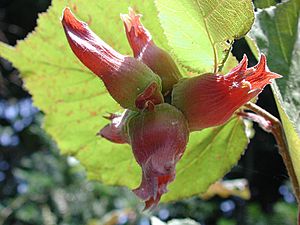Filbert facts for kids
Quick facts for kids Filbert |
|
|---|---|
 |
|
| Filbert nuts, showing their long, tube-like husks | |
| Conservation status | |
| Scientific classification | |
| Genus: |
Corylus
|
| Species: |
maxima
|
| Synonyms | |
|
|
The filbert (scientific name: Corylus maxima) is a type of hazel plant. It belongs to the birch family called Betulaceae. This plant grows naturally in southeastern Europe and southwestern Asia. You can find it from the Balkans all the way to Ordu in Turkey.
The filbert is a deciduous shrub. This means it's a bushy plant that loses its leaves every autumn. It can grow quite tall, usually between 6 and 10 meters (about 20 to 33 feet). Its main stems can be up to 20 centimeters (about 8 inches) thick.
The leaves of the filbert are round. They are usually 5 to 12 cm (2 to 5 inches) long and 4 to 10 cm (1.5 to 4 inches) wide. Their edges have a rough, double-sawtooth shape.
Filbert flowers are called catkins. They are pollinated by the wind and appear in late winter. The male catkins, which carry pollen, are pale yellow and 5 to 10 cm (2 to 4 inches) long. The female catkins are bright red and very tiny, only 1 to 3 mm (about 0.04 to 0.12 inches) long.
The fruit of the filbert is a nut. These nuts grow in groups of 1 to 5 together. Each nut is 1.5 to 2.5 cm (about 0.6 to 1 inch) long. It is fully covered by a long, tube-like husk that is 3 to 5 cm (1.2 to 2 inches) long.
The filbert is very similar to the common hazel, C. avellana. The main difference is how the nut is covered. The filbert's nut is more completely enclosed by its long, tube-shaped husk. Other hazels with similar husks include the beaked hazel C. cornuta from North America and the Asian beaked hazel C. sieboldiana from eastern Asia.
What Filberts Are Used For
The nut from the filbert plant is safe to eat. It tastes a lot like a hazelnut (also called a cobnut). In the United States, filberts are sometimes used as a larger nut in mixed nut containers.
Even though they are tasty, filberts are not grown as often as common hazels for their nuts. They are sometimes planted in orchards, which are special farms for fruit and nut trees.
There is a special type of filbert called Corylus maxima 'Purpurea'. This plant has purple leaves and is very popular. People often plant it in gardens because it looks beautiful. It is known as an ornamental shrub.
The Name "Filbert"
In the state of Oregon, people often use the word "filbert" to mean all kinds of commercial hazelnuts. However, this way of using the word is becoming less common. Hazelnut growers in Oregon are trying to use the name "hazelnut" more. This helps their product appeal to buyers around the world and avoids confusion.
The word "filbert" comes from an old French word. Some people believe the plant was named after Saint Philibert. His special day is August 20th. It is thought that the nuts were ripe and ready to pick around this date.
See also
 In Spanish: Corylus maxima para niños
In Spanish: Corylus maxima para niños
Images for kids





